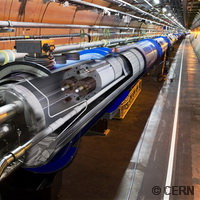Ambitious project 'unifies' laser and high-energy physics
An international team of experts are developing a revolutionary laser system by investigating the use of fibre lasers in ground-breaking particle accelerator technologies, such as the Large Hadron Collider (LHC), which is considered by scientists as one of the great engineering milestones of mankind. The ICAN ('International Coherent Amplification Network') project, which has received EU-funding of half a million euros, is a novel laser concept for high- energy particle acceleration. ICAN team members include experts in optical science, technology and industry, astronomy and manufacturing. Four renowned laboratories are also involved: ORC at the University of Southampton, UK; École Polytechnique, France The Fraunhofer Institute for Applied Optics and Precision Engineering (Fraunhofer IOF) Germany; and CERN, the European Organisation for Nuclear Research, Switzerland (and home to the LHC). It also involves a large number of worldwide partners from the laser, fibre and high-energy physics communities and industry. Together they will set out a new laser system composed of massive arrays of thousands of fibre lasers, for both fundamental research at laboratories and more applied tasks, such as proton therapy and nuclear transmutation. The project is led by Professor Gérard Mourou from École Polytechnique who is regarded as a pioneer in the field of ultrafast lasers. He says 'ICAN is a watershed project because it unifies laser and high-energy physics communities. 'I believe that ICAN is a bold and ambitious project, which illustrates the EU flagship innovative spirit.' Lasers can provide, in a very short time (measured in femtoseconds), bursts of energy, and equivalent to a thousand times the power of all the power plants in the world. Professor Mourou continues: 'One important application has been the possibility to accelerate particles to high energy over very short distances measured in centimetres rather than kilometres, as it is the case today with conventional technology. This feature is of paramount importance when we know that today high-energy physics is limited by the prohibitive size of accelerators (tens of kilometres) and costs billions of euros. Reducing the size and cost by a large amount is critical for the future of high-energy physics.' One significant societal application of such a source is to transmute the waste products of nuclear reactors, which at present have half-lives of hundreds of thousands of years, into materials with much shorter lives (down to tens of years). This would dramatically transform the problem of nuclear waste management.For more information, please visit: CERN - The European Organisation for Nuclear Research http://home.web.cern.ch/(opens in new window) École Polytechnique http://www.polytechnique.edu/jsp/accueil.jsp?CODE=36392593&LANGUE=1(opens in new window)
Countries
France



